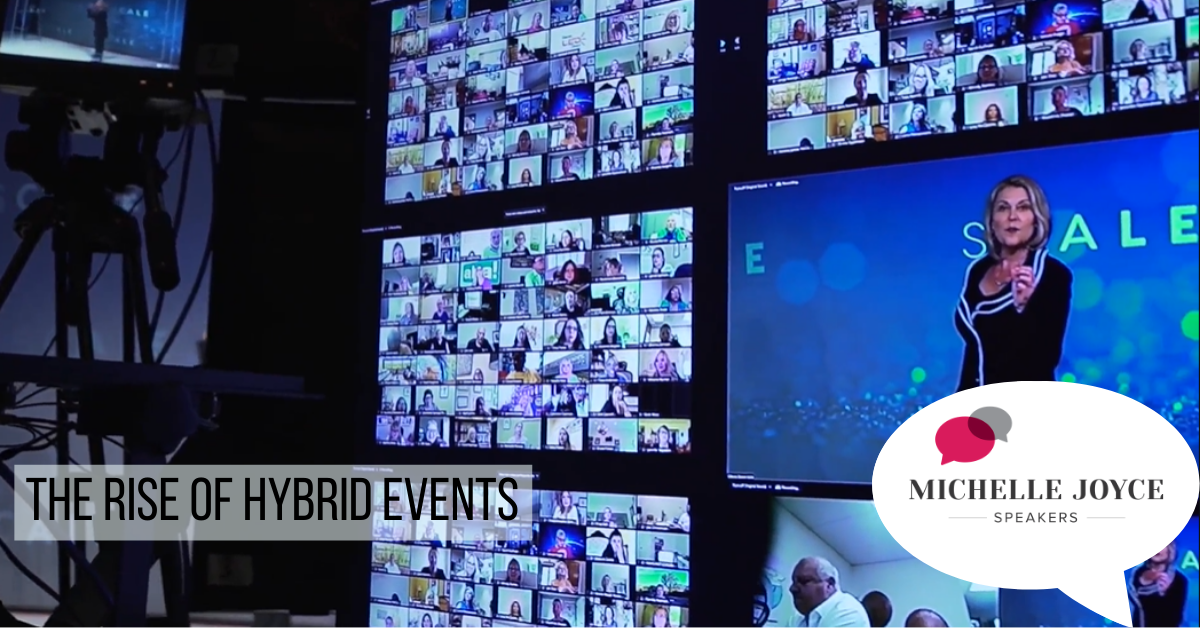Hybrid events aren’t new.
Do you remember being chosen to attend a big-deal conference that only some people in your company or department were able to go to? You felt singled out, recognized, even rewarded. Then there were those other times. The times you weren’t selected. You knew you were missing out on crucial networking opportunities and a chance to learn more about new developments in your industry.
How could companies allow more employees the opportunity to attend these events without breaking their travel budget?
The solution to that question turned out to be hybrid events.
These events, where some attend in person and others virtually, started gaining popularity before COVID-19 turned the event world upside down. And I believe they’ll continue to do so even after this pandemic is finally in our collective rearview mirror.
What are hybrid events?
Imagine a speaker on stage presenting to a ballroom of 100 people… while 2,000 more people around the globe watch via live stream. And when that speaker’s keynote presentation is over, audience members – both live and virtual – participate in real-time discussions and breakout sessions.
This is the new world of hybrid events. This is the future of meetings – possibly forever. Now is the time to learn all there is to know about hybrid events. The benefits and drawbacks, as well as what it takes to make one a success.
What are the benefits of a hybrid event?
An obvious benefit of hybrid events is the chance for more people to participate. Association members can bring their “whole office” to a conference or event, possibly for the first time. Companies can provide networking and training opportunities for more of their employees in a way that is more cost-effective than ever before. There are little to no travel costs associated with attending an event via live stream or video on demand.
What about the challenges of a hybrid event?
The biggest challenge of hybrid events is keeping both in-person and virtual attendees engaged at the same time. A keynote speaker needs to connect with the people who are physically in the room, while also connecting with the much larger audience attending via live stream remotely.
Meeting planners and event organizers need to be strategic when deciding both the content and the way it will be delivered. They must ask themselves:
- What will engage both audiences most effectively?
- What is the additional cost of a hybrid event?
- What additional technology will we need?
- Which keynote speakers have experience in delivering content in this format?
Keep in mind the goals of the event when making these decisions.
Cost is a factor that must be considered in hybrid events. In reality, putting on a hybrid event is like hosting two separate events simultaneously. Event organizers will be streaming the keynote speaker, eyeing discussions happening in the main room, and managing breakout sessions. The cost and complexity it takes to put on these events may add up quickly.
How can speakers engage ALL participants of a hybrid event?
Speaking at hybrid events presents unique challenges. Not only does a speaker have to engage, inform, and entertain the people in the room, he or she also must do the same for those watching virtually.
Speakers need to remain conscious of both audiences throughout their presentations.
Recently, our team went behind the scenes with Shawn Kanungo, a keynote speaker and disruption strategist who is quickly becoming known for creating amazing virtual and hybrid events. Working with his remarkable team at BAD Films, Shawn creates incredible and engaging experiences like the ones shown in this video.
According to Shawn, “Delivering an engaging keynote for a hybrid audience is much more difficult than in-person and virtual events combined. A speaker must create an immersive experience that feels inclusive for both in-person and virtual audiences, yet still feel compelling in both formats. It’s a fundamentally new format that very few speakers can elegantly pull off right away.”
Of course, having a speaker who is known for outstanding audience engagement helps. Those speakers who are already pros at keeping audiences interested or even enthralled in person are more likely to be able to do the same for virtual audiences.
Our own Scott Shellstrom is more than up to the challenge of engaging audiences wherever they happen to be. Known as a modern-day DaVinci, Scott inspires, educates, and amazes audiences through his unique take on creativity, innovation, and teambuilding. (He’s also an accomplished artist who speed-paints a masterpiece painting at every event!)
Companies and their employees have undergone tremendous change in the past year. Our own rock star speaker Jim Knight teaches organizations what it takes for them to attain rock star status themselves. His presentations focus on leadership, company culture, customer service, and employee engagement – in other words, all the facets of business that are more important now than ever before.
Hybrid events are likely here to stay.
Hybrid events allow for organizers to reach larger audiences and for companies to allow more employees access to event content. This makes hybrid events appealing now and in the future. (And we’re already seeing this trend with our clients.) When done well, hybrid events can be beneficial for everyone.






